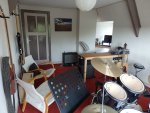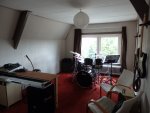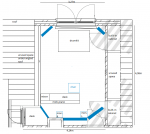Dicus
Enthusiastic Member
Hey guys,
I've been checking and loving this forum for a while now but never have done much posts. Coming year however I'd like to take my music and my studio to a higher level which brings me to quiet some questions regarding studio building and investments I have to make.
This room has mainly been used for songwriting and practicing with my band, for teaching the drums and also for compositions I sometimes make for advertisements and other short videos. I have recorded some stuff but mainly for ourselves to remember what we wrote. I'd like to be able to make nice demo's, as professional as possible within the limits of this space, my abilities and my money . I would also like to design it a bit since I think that might make the songwriting and teaching in this room more enjoyable and for teaching it also helps to look professional. And while I also have much equipment that needs improving I'd like to start with the acoustic treatment so I can finish the design of my studio.
. I would also like to design it a bit since I think that might make the songwriting and teaching in this room more enjoyable and for teaching it also helps to look professional. And while I also have much equipment that needs improving I'd like to start with the acoustic treatment so I can finish the design of my studio.
My main question is what should I do regard acoustic treatment. I found on the interwebs that Rockwool 221 (55kg/m3) is good stuff for acoustic treatment, when you staple a piece of cloth over it, and that 15cm of it would be best. I had the idea that it could save room if I made some holes in the walls marked with 1 and 2 to place the insulation in line with the wall to create a basstrap, I have got, however, no idea if this would work (and also got to ask my landlord for permission).
To long didn't read: How should I go about with acoustic treatment in this room and is it a good idea to place Rockwool in the spots marked with 1 and 2? Thanks a lot!
If you're still with me and would like to answer some more questions (feel free to direct me to another part of the forum if that would suit some of the questions better).
I put thick carpet with two layers of heavy undercarpet on the floor to make the noice, while I read in another post that hard wood is preferable. I think putting the drumkit straight on the wood with nothing in between wouldn't make my housemates happy, any suggestions what to do in this case?
A third question I have is the following. I have saved some money to spend on gear and am not really sure what to spend it on. I'd like to buy a device with which I could track 12 or more tracks simultaneously. At the moment I do everything with my M-audio Fast Track Pro. I'm also considering to upgrade my Garageband to Logic mainly for the extra midi-sounds that come with it, this could help me tremendously with the composing for short videos which I do mainly on my midi-piano. I always read on this forum that you should really have studio monitors but until now comparing the sound of 2 headphones and 5 sound systems took some time but made me able to create a nice mix/master of my tracks. Eventually I'd like to invest in all of the three but for now I've got to choose. Anyone any advice which of the three I should give priority?
Thanks a lot already! I love this forum and all the knowledge that is gathered here!

I've been checking and loving this forum for a while now but never have done much posts. Coming year however I'd like to take my music and my studio to a higher level which brings me to quiet some questions regarding studio building and investments I have to make.
This room has mainly been used for songwriting and practicing with my band, for teaching the drums and also for compositions I sometimes make for advertisements and other short videos. I have recorded some stuff but mainly for ourselves to remember what we wrote. I'd like to be able to make nice demo's, as professional as possible within the limits of this space, my abilities and my money
 . I would also like to design it a bit since I think that might make the songwriting and teaching in this room more enjoyable and for teaching it also helps to look professional. And while I also have much equipment that needs improving I'd like to start with the acoustic treatment so I can finish the design of my studio.
. I would also like to design it a bit since I think that might make the songwriting and teaching in this room more enjoyable and for teaching it also helps to look professional. And while I also have much equipment that needs improving I'd like to start with the acoustic treatment so I can finish the design of my studio. My main question is what should I do regard acoustic treatment. I found on the interwebs that Rockwool 221 (55kg/m3) is good stuff for acoustic treatment, when you staple a piece of cloth over it, and that 15cm of it would be best. I had the idea that it could save room if I made some holes in the walls marked with 1 and 2 to place the insulation in line with the wall to create a basstrap, I have got, however, no idea if this would work (and also got to ask my landlord for permission).
To long didn't read: How should I go about with acoustic treatment in this room and is it a good idea to place Rockwool in the spots marked with 1 and 2? Thanks a lot!
If you're still with me and would like to answer some more questions (feel free to direct me to another part of the forum if that would suit some of the questions better).
I put thick carpet with two layers of heavy undercarpet on the floor to make the noice, while I read in another post that hard wood is preferable. I think putting the drumkit straight on the wood with nothing in between wouldn't make my housemates happy, any suggestions what to do in this case?
A third question I have is the following. I have saved some money to spend on gear and am not really sure what to spend it on. I'd like to buy a device with which I could track 12 or more tracks simultaneously. At the moment I do everything with my M-audio Fast Track Pro. I'm also considering to upgrade my Garageband to Logic mainly for the extra midi-sounds that come with it, this could help me tremendously with the composing for short videos which I do mainly on my midi-piano. I always read on this forum that you should really have studio monitors but until now comparing the sound of 2 headphones and 5 sound systems took some time but made me able to create a nice mix/master of my tracks. Eventually I'd like to invest in all of the three but for now I've got to choose. Anyone any advice which of the three I should give priority?
Thanks a lot already! I love this forum and all the knowledge that is gathered here!





